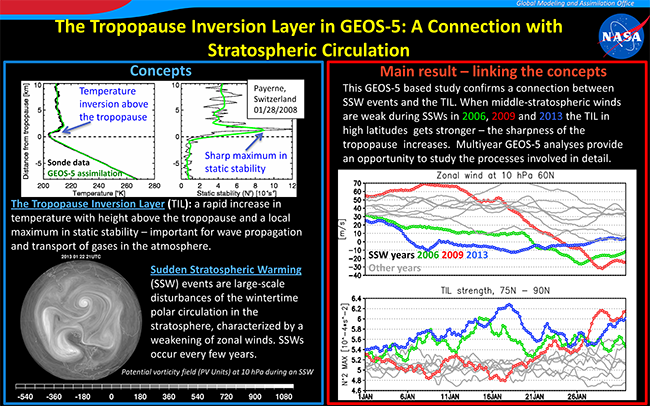The Tropopause Inversion Layer in GEOS-5: A Connection with Stratospheric Circulation
The Tropopause Inversion Layer is a prominent feature of the extratropical tropopause region, characterized by a positive temperature lapse rate associated with a sharp increase in static stability immediately above the thermal tropopause. We use the maximum buoyancy frequency squared (a convenient measure of static stability) within the 3 km thick layer above the tropopause to quantify the TIL’s strength. The mechanisms responsible for the formation and maintenance of the TIL are not yet fully understood but it has been demonstrated that near-tropopause circulation plays a crucial role.
A Sudden Stratospheric Warming (SSW) is a large-scale disturbance of the stratospheric polar vortex during winter. It is associated with an increase in temperature over the pole and a weakening of the circumpolar winds. Such disturbances begin in the upper atmosphere and descend all the way to the tropopause and below over the course of several days.
Grise et al., [2010] noted that high-latitude above-tropopause static stability is enhanced during SSW events. In this work, we use a 9-year long GEOS-5 analysis experiment to confirm this result and study the variations of the TIL’s strength during three major SSW events that occurred in January of 2006, 2009, and 2013. In 2006 and 2013 the vortex became gradually more and more disturbed throughout the month, while in 2009 the warming occurred rapidly after 20 January. The anomalously high strength of the TIL followed the same pattern. In particular, the TIL was the strongest during most of January in 2013 when the 10 hPa zonal winds were the weakest. The most likely mechanism responsible for this correlation is the descent of positive temperature anomalies associated (by construction) with SSW events but enhanced wave-breaking near the tropopause may also play a role. The goal of this research project is to assess the relative contribution of these processes.
Reference
Grise, K.M., D.W.J. Thompson, and T. Birner, 2010: A Global Survey of Static Stability in the Stratosphere and Upper Troposphere. J. Climate, 23, 2275-2292.


